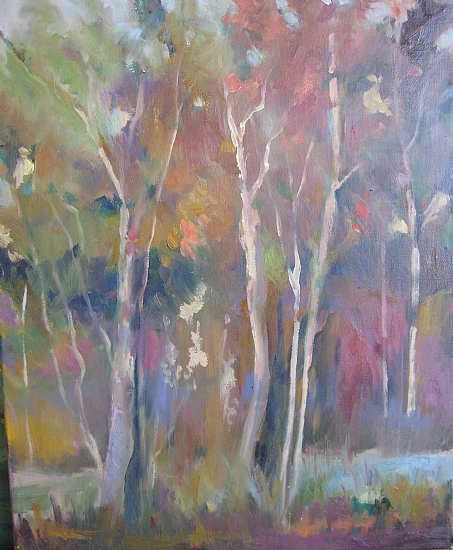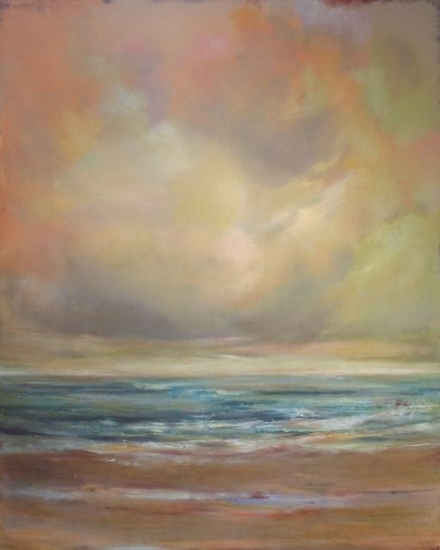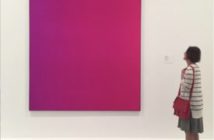Thanks to everyone who took the online colour test mentioned in my last letter. You can still take it here. It was a major job for Sarah Garland to go through and calibrate your results. As of Friday, July 1 at 5 pm PDT, 2989 readers had reported taking the test–2508 women and 481 men. There were 18 by the name of Sue, Susan, Suzan or Suzanne, etc., but none of them claimed to be men. Other readers reported they took the test but did not report a score. In our calculations we did not include those of unknown gender. The average score reported for all the women was 18.28 and the average score reported for all the men was 35.44. Zero was the perfect score and 228 women and 42 men got it. According to our figuring this means that 9.09% of women got perfect scores, while 8.75% of men got perfect scores. Pretty close. We could not see a significant difference in scores between older and younger people. There were some very elderly people of both sexes with perfect scores. Anecdotally, elderly people did very well—perhaps because they patiently took their time. The four worst scores (900 or over) went to men. There were a few women with relatively poor scores as well. Further, many older persons who reported a lifetime of related colour judging experience scored well, in spite, in some cases, of also reporting macular degeneration, cataracts, floaters, etc. Further, most people who took the test more than once reported they improved on the second try. Based on many, many remarks and observations, we think the quality of monitors may have an effect. Older, smaller monitors might not have been as clear or true as newer, larger ones. Some even tested themselves on two computers in their own homes and received better results on better monitors. (“My old one and my husband’s nice new one”) As well, we did not differentiate between Mac and PC users. I think we perhaps should have. Thanks to everyone who participated. As we watch this inbox, the results are still coming in. It’s my sincere wish that the test was of value to you, and that you not get disgruntled if you scored poorly. If we get further significant input or statistics, we will report them to you.
Gallery job upsets artist by Lynda Leonard, Kansas City, KS, USA I worked for years in Santa Fe, New Mexico art galleries and some of what I experienced with the “flavor of the month” thing affected my art very much. I stopped doing anything creative for too long. I just had to rethink about what it was I was doing and why. It has created a dilemma for me and my creativity that has not yet been resolved. The measure of success by Luann Udell, Keene, NH, USA This is the most pragmatic, down-to-earth piece on the nature of success and art collectors I’ve ever read. I thought it would depress me but it didn’t. Instead, it reinforced the subtle change in my attitude toward my art that’s been going on for a handful of years now. I used to want to be ‘successful,’ until I asked myself what that really meant for me. Would I measure my success by the dollar? By the number of galleries representing me? By how well-known my work was? Did I want to be the ‘flavor of the month-year-decade’? Or did I want to make the work that’s the most emotionally and spiritually rewarding for me — and my customers/audience? In the end, I decided the latter is my own personal life goal — to enrich my life, and that of my audience, be it twenty or twenty thousand people, expressing and sharing my own unique vision of the world. Oddly, I’m making more money than ever. There are 2 comments for The measure of success by Luann Udell Art dealers not all the same by Anonymous As an art dealer I can assure you that we are all not the same. But we do have one thing in common. We are in the business of building buyer confidence in art that the average artist cannot do on his/her own. Some do it with provenance, some with a simple appeal to the senses. Others do it by intimidation and the subtle interjection of potential investment values. Creating a sense of scarcity in an abundant art environment is one of our most difficult tasks. Art is everywhere but not everyone can tell the good stuff… even some dealers. Ridiculous prices by Anonymous My wife and I own a successful gallery that carries mostly decorative works that sell mainly on their own appeal. Many people just feel they need art in their home and buy large florals or colorful abstracts or semi-abstracts. We sell a lot of beautiful realistic work as well. Our business is in lockstep with the building and realty business. As walls are built, things of beauty are needed to go on them. In this recession things are highly competitive. It’s tough. Other galleries in our area cater to the more snobbish and upwardly mobile and charge ridiculous prices for often inferior work. In the art business, the poorer the work, the more likely you are to see a high price on it. My wife and I can only conclude that a high price is often a sales point. The dynamics of male/female success by Carol English, Ottawa, ON, Canada Regarding many women painting but more men succeeding, it might be because it is so much more socially acceptable for women to identify themselves as artists. Thus, only the fairly dedicated and/or talented men even bother putting themselves out there. This doesn’t negate the issue at all but might indicate that it isn’t as extreme as one might think. The opposite effect tends to happen for some male dominated professions: When I was younger there were very few women entering the engineering profession. However, the few who did choose to study engineering tended to be at or near the top of their classes. This wasn’t because women make better engineers, but because a woman had to do really, really well in math and science before she would consider even trying to compete. There are 2 comments for The dynamics of male/female success by Carol English Peacock feathers by Norman Ridenour, Prague, Czech Republic One of the many things I do is teach a university course in, Visual Arts. Lesson One. What is art? One page! Final exam, 2. What is art? For the artist? For the collector/buyer? What does it do to help our survival as a species? Why do we make, have and keep art? (A species only does things over several generations which help the species survive. If a set of actions or behaviors do not aid the continuation of the species they are soon abandoned. Therefore art must aid in survival. How?) The really interesting aspects are: The students are: a. Non-western b. Mostly Muslim c. Business students Talk about getting students to think! Of course there is no ‘right answer.’ This also drives them crazy. Norman, what is the answer????? My personal take is that for most ‘collectors’ art acts like Peacock tail feathers. It shows that you are potentially a good mate and a bit different from the average. Building integrity into art by Brigitte Nowak, Toronto, ON, Canada Let’s be grateful that people with the resources to do so, spend some of their cash on the un-necessities of life, like art. Whether they do so to decorate their environment, to surround themselves with beauty, because a particular piece has resonated with them, or because their decorator or curator told them they needed it, is less important than the fact that they could have put their money into mutual funds, cars, their pets or other toys, but they chose art. Of course it is frustrating, for the vast majority of artists who are not part of this month’s “in” crowd, to see the work of other, sometimes less worthwhile, artists leap off gallery walls, while their own work languishes under the bed. For some, the solution may be to change their flavour to conform — usually a significant career-limiting move, because most reasonably erudite collectors, or their curators, can see through this — it suggests that the artist has neither integrity nor vision. Others carry on with trying to make their work the best it can be, to continue to try to reveal the mysteries of the world, and discover that they may have become this month’s flavour. The private love of art by Christie Zwick, Calgary, AB, Canada I suppose that if you have art in your house that you want others to see and be impressed by, then collection by curation is fine. I buy art when something grabs my eye. It might be colour or composition or a triggered memory. The art I buy intrigues me on some level. We are not rich and our house does not see many people that are not family and friends, but I think things would be the same if we were millionaires. Don’t get me wrong, there are some pieces I would LOVE to have in our home that fit the criteria you mentioned, but it would make me feel ill at ease to have something in my home that did not appeal to me on some level. There is 1 comment for The private love of art by Christie Zwick Juicy flavours by Jean Nelson, Oregon City, OR, USA I have noticed more and more, that some artists paint with and refer to brush work as “loose” and “juicy.” I have mixed feelings, personally, about this trend and don’t know whether it is a good thing and something I should try to emulate, or not. I have been painting for only about a year and a half and I guess you could say I am still testing the waters in finding my style. Sometimes the edges of an object in this loose style of painting — say a plate — are more octagonal than round which bothers me. Other times I like the way this technique looks. What are your thoughts — is it a fad or a better way of applying paint? Enjoy your letters and as a ‘new’ artist have learned much from them. (RG note) Thanks, Jean. “Juicy” is currently popular in part because it shows texture and avoids the confusion with prints and reproductions, which are currently cycling down because of oversupply. But the rule applies: Do what you love. There is 1 comment for Juicy flavours by Jean Nelson Mutual approval by Pierre Vachon Madonna is a successful artist of contemporary popular culture. I would love to know if she buys art using the same standards she has employed to achieve success in her field, or does she take a longer and less utilitarian approach? Money wise, whoever buys what Madonna has acquired, will enhance the value of Madonna’s choice. Possibly that’s all that interests Madonna but it is a symbiotic relationship. Love story by John Ferrie, Vancouver, BC, Canada Maybe I am not very smart or maybe I am just an artist trying to claw my way from the doldrums and have my voice heard. But in this day and age, if you get a buyer, TAKE IT! Sometimes the same buyer comes back, sometimes they bring a friend. Sometimes someone has something the other one wants and if this happens, TAKE IT! Buyers don’t come around very often and if there is a swell of buyers, they usually don’t last very long. So often, people want me to see their collection of art. I play along like I have a clue what they are showing me and how flattered I am to be considered to be part of their collections. It is all part of the selling dance. There are artists out there who are so concerned where their art is going, who they sell it to and where they hang it. I guess I am different, because a sale is a sale and once that check clears, they can hang it on the ceiling of their outhouse for all I know. Galleries can turn the spot light on an artist and there is all this flurry and excitement. Articles are written and incomprehensible critiques are published and everybody sits up and takes notice and yet nobody seems to know better. At the end of the day, I always say, “You are not allowed to buy my work unless you love it.” It is the buyer who has to live with this work. Keeping up with the Jones’s is one thing, but living with a painting should be about a love story. There is 1 comment for Love story by John FerrieArchived Comments
Enjoy the past comments below for Flavour of the month…
ahhh that explains the why some artists sell most everything.
People make art, and look at art, and buy art, for hundreds of different reasons – isn’t that the beauty of it. Let’s be grateful that people with the resources to do so, spend some of their cash on the un-necessities of life, like artwork. Whether they do so to decorate their environment, to surround themselves with beauty, because a particular piece has resonated with them, or because their decorator or curator told them they needed it, is less important than the fact that they could have put their money into mutual funds, cars, their pets or other toys, but they chose art. Of course it is frustrating, for the vast majority of artists who are not part of this month’s “in” crowd, to see the work of other, sometimes less worthwhile, artists leap off gallery walls, while their own work languishes under the bed. For some, the solution may be to change their flavour to conform – usually a significant career-limiting move, because most reasonably erudite collectors, or their curators, can see through this – it suggests that the artist has neither integrity nor vision. Others carry on with trying to make their work the best it can be, to continue to try to reveal the mysteries of the world, and discover that they may have become this month’s flavour. Artists who expect to succeed need to create work that has something original to say, that shows progression and cohesion from one work to the next and that is competently executed. They need to get that work out from under the bed and onto gallery walls where it can be seen – and hopefully appreciated – by collectors, curators, etc. Of course, most collectors and curators tend to fish in the same pond of “in” galleries, and read art magazine articles by the same art writers, and attend the same museums, art fairs and exhibitions, all of which champion the same small coterie of “in” artists. But there is always room for one more, whether that is an artist with a unique vision or a quirky collector.
Yep, we’re like those 2-year-olds in a room full of toys. When one child picks up a particular toy, another child is suddenly interested in it.
Poetry, rare Art invites ancient pens to create Dance on paper, life-giving, saviors are words gifted into poems…
I must always remind myself, and others, that the making of art, and the selling of art, are two different activities. We are often not understood, and often we don’t understand them. Let’s keep on making and let them do the selling. Hey! Maybe Madonna will have one of ours ;-) Best to all the creators and the collectors. Montreal, Canada
My recent experience with collectors: We are showing pastels from across Canada this month in Qualicum Beach, B.C. Our featured works are from private collections and I find the owners of these works eager to have their treasures viewed. Along with the pastels themselves come the stories, connections and influences from some of our other great Canadian artists.
As a gallery worker I am quite often able to help people decide between two or more paintings or sculptures. They know they want one of the artist’s work, but they are afraid to make a decision for fear they make a bad one. People very often favor the brightest work, but are afraid to admit it. By watching people you can confirm their choice often with a smile or a nod and make them feel good about making it. Also, when left alone for a short period of time, without the salesperson breathing down their neck, a pair of customers often come to a conclusion by confirming choice between themselves. Not all customers are totally without confidence. They have bought before and merely want to prolong the good feeling they get when buying.
At the same time, most people covet what other people covet.
Ideas about fashion are particular to every culture and they are probably hard wired into Homo sapiens. Just as clothes become popular and then fade from view, people generally must know that what they have on their walls is at least current, if not “acceptable.” This need does not of course include people who madly collect various forms of historic art, although that too could be considered a form or retro-fashion. Some people are just difficult.
All individuals are not programmed the same way. Many, particularly the less imaginative or otherwise engaged, cannot make art themselves, so they more than appreciate those who can. This is a fortunate turn of events, for if all were capable of making their own art, there would be little or no sustenance for those who make it well.
Thank you so much for this blog.


Creek thaw pastel painting by Donna Shortt, IN, USA |















Well put Luann. From the heart always wins in the end for both the artist and viewer. One friend asked me early on why I didn’t paint peppers as they were so popular then, very glad I didn’t give in to that trend or any others. I remember Keene quite fondly as we used to shop and eat out there when we lived in Ashburnham. One of the best main streets I’ve ever visited.